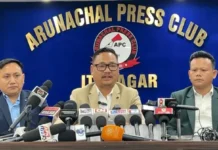[RN Koley]
The religious culture of ethnic communities imbibes psychological attitude regarding supernatural beliefs and practices. The rituals of that community also consist of a set of actions to make liaison between the performing individual and the supernatural powers.
Religious beliefs of the ethnic people of Arunachal Pradesh are mainly charter for the rituals. Their rituals are symbolic representations of age-old myths, beliefs and traditions. There are certain ideological beliefs behind observance of rituals besides fear psychosis. People believe in existence of different gods and goddesses and spirits. As per belief, they visit the eternal world to convey happy news. So, to welcome them, the people observe taboo day in the form of rituals before festivals. On those days, people intend to pave the road to spiritual serenity to overcome the dangers of day-to-day life and also to bring purity of mind. Thus, social doctrines are being inculcated among the people, which act as social control in the society.
In fact observance of taboos, rituals and festivals are essential part of the socio-religio-cultural life of most of the ethnic communities in Arunachal Pradesh. These are commonly observed when traditional festivals are celebrated, spiritual offerings are made, tragic incidents occur, epidemic breaks out in the village, a person dies naturally or unnaturally in the village or family, abortive child births take place, heinous offences are committed, fire accidents break out, etc. In many ethnic communities, people suspend their day-to-day social activities like going to agricultural field, hunting, washing clothes, fishing and weaving as part of customary codes. In some communities, individual member of the family or members of village community are forbidden to go out of the family or village. Outsiders are not allowed to go inside the village. It is the traditional belief of them that the spirits causing the suffering or disease may accompany with the outsiders on those days.
Sometimes restrictions may be introduced to eat particular diet among many tribal communities.
It is a deep-rooted belief among most of the tribal communities of non Bodic group that there is influence or effect of spirits behind different types of occurrence of fortune or misfortune in their life cycle as part of their religious perceptions. They believe the existence of spirits or deities and unseen world behind every occurrence, incident in their socio-religious life. Thereby, the people try to seek mythological explanation behind imperceptible cause of sickness, bad harvesting of crops, accident, loss of mithun, delivery of dead child, abortion, bad dream, fire accident, snake bite, agony of death, etc. The people try to find out the existence of spirit when even a spring dries unnaturally, fishes become unavailable in the river, there is unprecedented crops damage and agricultural land or bamboo groves wither up, etc. Thereby, people endeavour to get rid of misfortune or to find out remedy to keep all sorts of problems and obstacles spiritually through offerings and sacrifice to particular spirits or deities. Therefore, ritual is observed at every stage in social, cultural, economic and religious life of tribal communities in community level or individual level.
All rituals, festivals and spiritual activities centre around the priest. The priests in most of the ethnic communities act as mediator between man and spirits as the guardian or the guide of the communities. The terms for priest are different from community to community such as Miri, Nyibu, Lama, Igu, Mugou, etc.
A priests acting as a diviner is capable of combating spirits. A priest, irrespective of community, should have psychic superiority with certain spiritual qualities and also the ability to foretell things to come. They are the spiritual guardians of the society and conduct all sorts of rituals and ceremonies for wellbeing of entire community. They are born. They are the distinguished person for contacting the world of spirits as the in-between of people to communicate the individual or individual’s grievances, sufferings, misfortunes and solution thereof. They have been trained by the seniors to enrich their skill of priesthood before they are recognized or accepted as a priest by the ethnic communities. Prior to that, an individual is identified as would-be priest for having some inborn specific qualities. While undergoing empirical training for priesthood, they have to be well acquainted with the properties of trees, plants and herbs and its medicinal value for curing diseases, mythology centering around different deities and spirits and their influence and activities, significance of divination, customary codes, knowledge on diet, ritualistic ingredients like musical instruments and leafs, method of rituals, identification of spirits responsible for any occurrence, magical significance and their impact in the society as part of traditional belief. These are actually traditional wisdom passed down orally from seniors to juniors.
A priest sometimes acts as a healer or a traditional medical practitioner or spiritual guide or detector of criminals and crime through performing ordeals or a simple worshiper. Thereby the priest occupies a dignified position in the community. So, institution of priesthood is still popular and vibrant in the community and maintaining the continuity of cultural tradition. Many writers used to generalize the tribal rites and rituals as superstitions or prejudices without conceptualizing tribal genesis. There is sufficient evidence of scientific notion behind the numerous rites and rituals. The beliefs, faiths and customs of tribal communities of Arunachal Pradesh are essential components of their cultural chords and have been practising since time immemorial as an outcome of traditional knowledge system. These have had strong cultural influence in the society.
Now, the time has come to patronage the institution of priesthood for augmentation protection and preservation. In many states, the priests are enlisted and getting honorariums from the government. Priestly languages are to be documented and preserved as valuable oral literature. In earlier days, these oral literatures could not be handed down due to lack of written literature. Nowadays, the initiative has been undertaken by directorate of research and the directorate of indigenous affairs to document, preserve and strengthen the institution of priesthood. This initiative may pave the way to get back the missing link of cultural tradition of Arunachal Pradesh.



